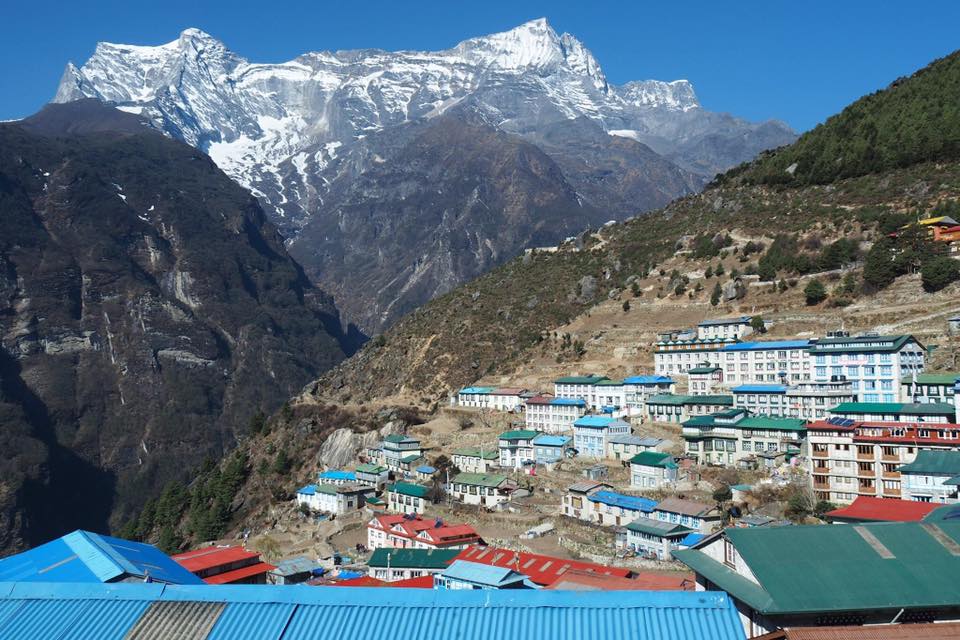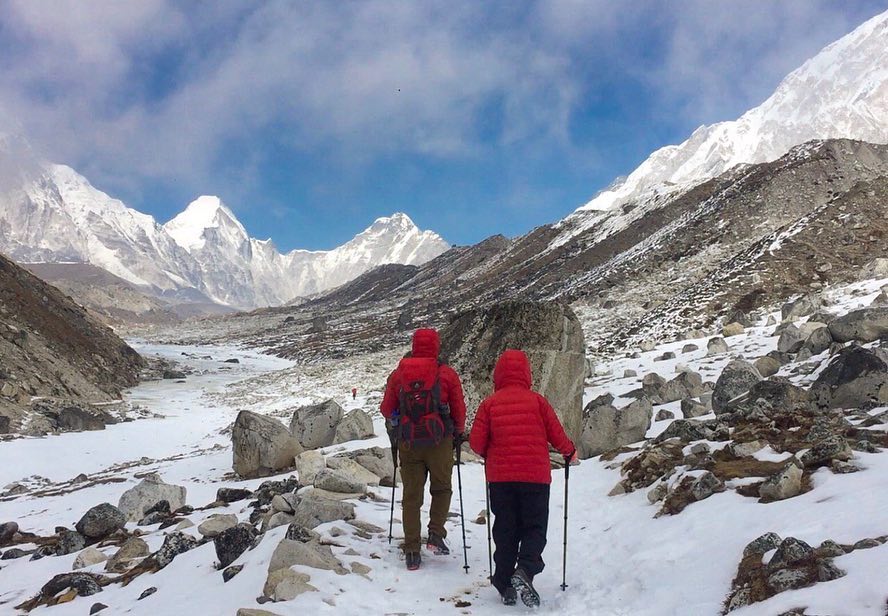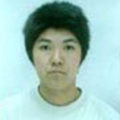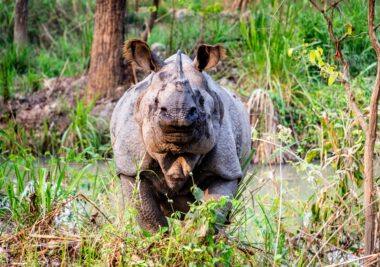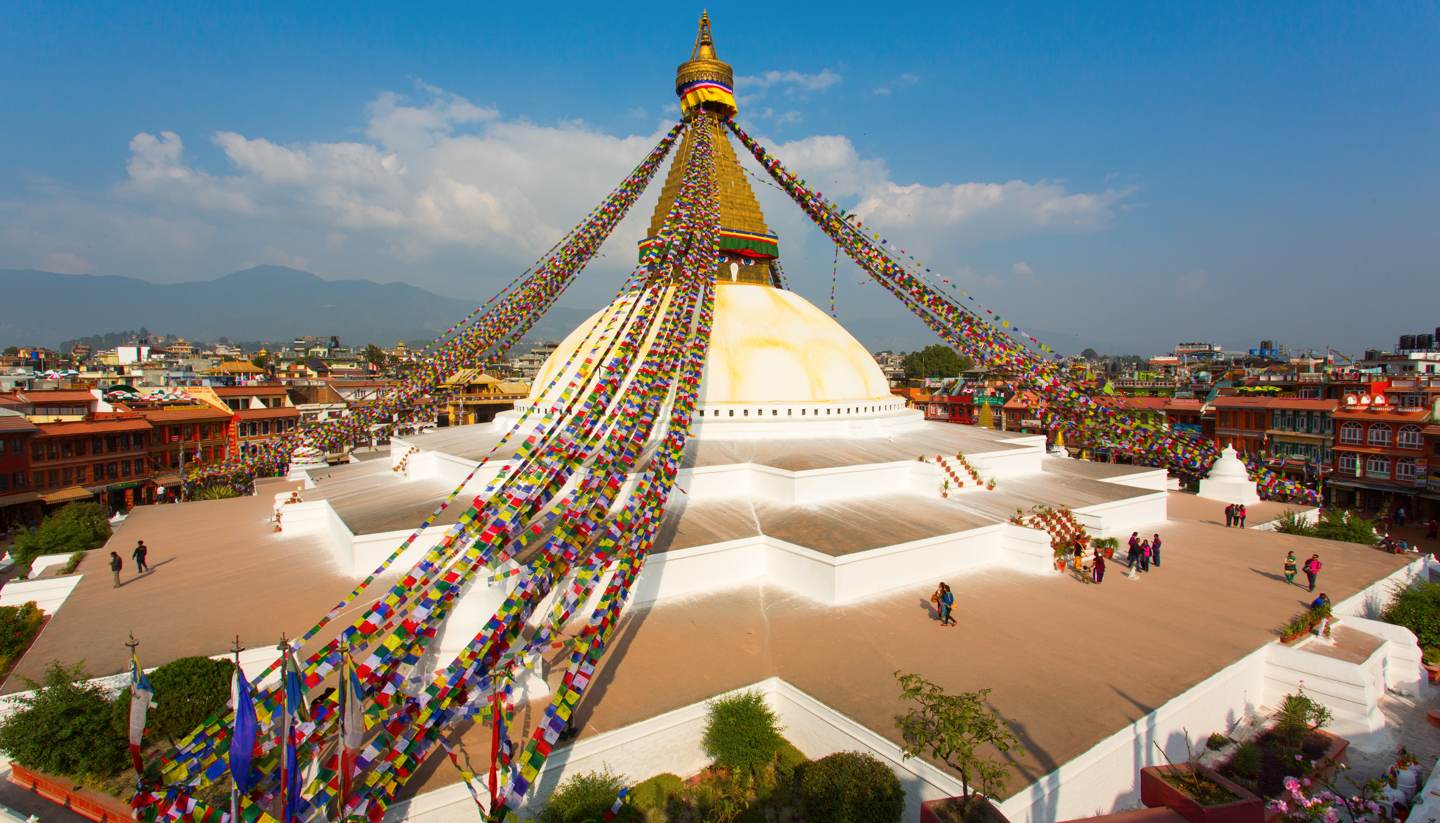EBC/Gokyo Lake Budget Trek – 15 days
- Based on 12 review(s)
This EBC/Gokyo Lake Budget Trek package combines EBC Trek and Gokyo Valley trek into one which first takes us to the foot of world’s tallest mountain Mount Everest and leads us to a serene Gokyo Valley.
Highlights of EBC-Gokyo Budget Trek:
- This trekking is once in a lifetime opportunity to see the top of the world Mt. Everest (8,848.86) from nearest point possible.
- Visit Gokyo Vlley, one of the most serene valleys of Nepal at 5,357 meters.
- Take in the serene view of Gokyo Lake.
- Accommodations include tea houses and lodges, offering a glimpse into the Sherpa cultures of Nepali villages and fostering connections among fellow travelers.
- Considered moderately difficult, the trek rewards trekkers with stunning views of Mount Everest, Mt. Lhotse, Mt. Amadablam and many more.
- The Everest Base Camp trek stands out as a well-rounded adventure, combining challenging terrain, cultural richness, and awe-inspiring mountain vistas.
- Trekkers will get the opportunity to taste amazing local Nepalese foods, with exceptional mountain views.
- Taste the local homemade alcoholic beverages called Tongba, Chyang etc.
Trip Overview
What is Budget Trekking?
Budget trekking is the best option for travelers who want to experience the Himalayas with a limited budget. For all the trekking enthusiasts in the world, we invite you to visit Nepal and explore this Himalayan region with comfort and a reasonable price.
Your essentials for hiking in the Himalayas will be covered by our budget packages. To ensure that your walk is comfortable, we supply you with obliging and amusing porters (English speaking) who will carry up to 12kgs of weight. As porters are experienced trekkers, they will also be help you with your needs during the trek. Included in the budget trek cost are additional services like ground transportation to and from the starting and finishing points of the trek, cozy and warm lodges during the trek, and permits required to trek in Nepal’s various trekking regions.
It should be noted that hiring a guide will come at an additional expense, raising the overall cost of the trek. However, if you feel the need, we can also provide excellent guides for you. And lastly, we request our travelers to carry the basic necessities such as trekking gears, warm clothes, hot water bottles, sunglasses, trekking poles etc. with themselves as it will not be provided by the company.
This EBC/Gokyo Lake Budget Trek package combines EBC Trek and Gokyo Valley trek into one which first takes us to the foot of world’s tallest mountain Mount Everest and leads us to a serene Gokyo Valley.
One of the most popular trekking routes in Nepal is the Gokyo Lake Trek, which leads trekkers to the Gokyo Valley, the glacial lake’s birthplace. The Gokyo Lake Trek begins at Lukla, which is 30 minutes distant by plane from Kathmandu Valley. It is situated inside the Sagarmatha National Park in the Everest area of Nepal. The average time to finish this 92-kilometer climb is roughly 12 days. The tallest peak on this hiking route, Gokyo Ri, rises to 5,357 meters and provides stunning views of Cho Oyu, Makalu, Lhotse, and Everest.
A thrilling trek known as the Everest Base Camp (EBC) trek takes hikers to the base of Mount Everest, the highest mountain in the world. The thrilling EBC trek journey in the Lukla village of Nepal’s Khumbu district starts with an exhilarating flight to Tenzing-Hillary airport, one of the most hazardous and high-altitude airports in the world. Enjoy breath-taking vistas of the surrounding alpine region during the 35-minute flight. The 130-mile EBC journey, which can take 10 to 15 days to finish depending on the route and physical fitness level, is thought to be one of the more challenging treks. The best months to visit the EBC Trek are mid-September through November or March through May. Over the course of the EBC Budget Trek, trekkers will ascend steadily to a maximum elevation of 5,364 meters (Everest Base Camp).
Trekkers can stay in cozy tea houses and lodges along the trail, where they can enjoy Nepali food like dal bhat tarkari and socialize with friendly Sherpas and other ethnic cultures. The EBC/Gokyo Lake Budget Trek’s best trekking seasons are from March to May in the spring and from September to November in the fall. The largest glacier in the Himalayas, Nozumpa Glacier, is one of the trek’s highlights. The Gokyo Lake trek, which starts at Everest Base Camp, is an alternate route to the EBC trek, which is also regarded as difficult.
DETAILED ITINERARY
After your breakfast, you will be picked up by our porter and be transferred to the airport. After we get on to 30 minutes of flight to one of the most exhilarating airports in the world i.e. Lukla airport. This flight provides with amazing views of the tallest peaks in the world.
After arriving in Lukla, we officially begin our trek by heading onwards to Phakding. It is an amazing sherpa village with warm and hospitable people. First day of trekking officially ends as we stay for the night at a local lodge in Phakding.
We start our journey in the direction of Namche after breakfast in the morning. Also referred to as the “getaway to Everest,” this location offers you banking and internet access, among other amenities that you would not find in the places up ahead. Stay the night at a nearby lodge in Namche.
We will take a rest day as per protocol to allow our bodies to adjust to the higher altitude. Enjoy the views of the mountains by taking a quick trek to one of the closest viewpoints. In the evening, meander through Namche’s streets. Go to Namche for the night.
Today, we head onwards to Debuche village, which is a remote and isolated village in Everest region with nice and hospitable Sherpas. Along the way you’ll also get to visit Tengboche Monastery, which is also known as one of the oldest monasteries in the world. Stay your night at Debuche at a local lodge.
Starting from Debuche in the early morning, we make our way to Dingboche, a tiny, isolated town near Mount Everest. Enjoy regional cuisine while taking in breathtaking mountain vistas. Rest well in your comfortable and warm accommodation in Dingboche’s local lodge.
We are going to Dingboche for another day of rest. Given that the altitude is over 4,000 meters, adequate rest and acclimatization are required. We’ll spend the night in Dingboche and go for a quick climb around the closest views.
It’s gets more exciting from here on. As we move toward Lobuche today, we come closer to the Base camp. Should the weather cooperate, you will witness once-in-a-lifetime sights. After a thrilling day of exploration, spend the night at Lobuche.
At last, this is the day. Even though the hike will take a little longer, it will be well worth it. We make our way to the 5364-meter-high Everest Base Camp. You’ll accomplish something most intrepid people in all over the world would hope to accomplish at least once in their lifetime. Take photos, enjoy the scenery to the fullest, and record a story for the next generation. We’ll return to Gorakhshep and stay the night at a nearby lodge.
Today we hike to Kalapathhar, the highest we gain in this classic EBC Budget Trek. The largest glacier and waterfall in Nepal, the Khumbu glacier and Icefall, as well as the peaks of Pumori (7,161m), Lingtren, Everest (8,848m), Nuptse (7,861m), Amadablam (6,812m), Khantega, and Taboche are all visible from Kalapatthar (5,550m). Head to Zhongla and stay the night.
Today, we head onwards to Thangna village. A remote village in a very high altitude of 4500 meters. Along the way we pass Chola-La Cross, which is one of the highest altitudes we reach during this trek.
Finally, today is the day we reach Gokyo Valley, a serene valley located at the altitude of 4,790m. Gokyo valley is surrounded by mountains and with Gokyo Lake in the middle. Take your time to click as many pictures as you like, while you stay at a local nearby lodge of the valley.
Today we hike up to Gokyo Ri, which is one of the highest altitude we reach during this trek. Situated at the attitude of 5,483 meters Gokyo Rii provides with breathtaking views of Mount Everest, Mount Amadablam, Mount Lhotse with many more surrounding mountains in the region.
Following breakfast in the morning, we head downhill towards Namche, which is known as the gateway to Everest. Savor the amenities of warm water, internet, and nearby eateries. Local stores also offer mementos for you to buy and bring home. Arriving at Namche Bazaar and stay the night.
Today is our last day of trekking to Everest Base Camp before returning to Lukla. Because of its scenery, Lukla Airport is known to be one of the most thrilling airports in the world. Stay overnight at Lukla.
We will finally take a quick flight return to Kathmandu via Lukla airport after an 11-day journey. You will be driven in a local vehicle to your drop off point in Kathmandu. The remainder of the day is yours to pack or take leisurely strolls throughout Kathmandu.
Note above itinerary:
What to expect?
Price Includes
- All the ground transportation by tourist vehicles.
- Twin sharing comfortable and clean private room in trekking.
- Trip Map.
- Both ways domestic flight tickets from KTM/Lukla/KTM with airport tax.
- An experienced, helpful English-speaking trekking cum porter ( He does guide and as well as carry your sum trekking gears).
- Food, drinks, accommodation, insurance, salary, equipments, transportation, local tax for Guide and porter.
- Group medical supplies (first aid kit will be available).
- Four season sleeping bag and down jackets to use for trekking, if necessary.
- Duffel/kit bag( Gift from our company).
- All necessary paper works and National park/ Conservation entry permits.
- Travel & Rescue arrangement which will be paid by your insurance company.
- TIMS (Trekkers' Information Management System).
- All our government taxes, vat, local tax, tourist service charges.
Price Excludes
- Meals and drinks in the mountain (costs roughly USD 25 to USD 30 per person per day)
- Personal equipment.
- Travel and rescue insurance.
- Extra personal expenses (phone calls, laundry, bar bills, battery recharge, laundry, shower, excess baggage charges)
- Tips for trekking staff and driver (Tipping is expected)
- Any others expenses which are not mentioned on 'Price Includes' section.
Frequently Asked Questions
Common questions about company
Locally owned and managed, the company established in 1999, has earned its reputation by the dedication and hard work of the knowledgeable, friendly and well -trained staff. Safe, enjoyable travel are the hallmark of Unique Path, and the best way to achieve that is a combination of accurate preparation and realistic expectations. With this in mind, we work honestly and effectively to provide you the Himalayan experience that suits your interest.
We respect and follow our clients’ suggestions and ideas for planning their holiday. Our aim is to take you to a world totally different from your own and allow you to connect (or re-connect) with your own spirituality. Our hope is that all of our clients will leave Nepal with grand tales to share with their family and friends at home and will want to return again and again to their new friends in Nepal.
It is important to be aware that there are many companies running business with expired licenses; business that do not observe the legal formalities imposed by the country act. In the same manner, we have seen many examples of so – called trekking / touring agencies illegally operated by individuals & freelancers through their own personal websites.
Finally, if you book your trip with an unauthorized agency in Nepal or abroad, there is a greater risk that problems will occur during the course of your time in Himalaya. In order to protect yourself from these problems, take the following hints into consideration prior to confirming your journey with any trekking or travel agency. We’ve ensured that our certificates are up-to- date and in proper order.
All of our trips are led by qualified professional guides, who are well trained by our Government. We believe that our incredible guides and staff are the foundation of our programs. All of our guides are highly skilled professionals who have been selected based on their technical proficiency, proven safety records, careful judgment, patient and supportive teaching styles and great personalities.
Our job is to ensure your comfort and safety as we take you where you want to go, because your holiday is ours. Our guides are trained by the Nepal Mountaineering Association, the Ministry of Tourism and at the High Altitude Medical Training Center. Guides are very experienced in dealing with the effects of higher altitudes and since they are natives of Nepal, they easily acclimatize and therefore can better care for their clients. They are equipped with necessary medical supplies and can assist you with basic first aid treatment.
Nepal's location/ Entry information/Visa
Nepal is a landlocked country in Southern Asia, bordered by China to the north and India to the east, south, and west. It lies along the southern slopes of the Himalayan mountain ranges, making
it the largest sovereign Himalayan state. The capital city is Kathmandu, which is also the largest city in Nepal.
Nepal is a popular tourist destination in south Asia. Several airlines have direct and non-stop flights from Middle East and Asia to Tribhuvan International Airport (TIA), Kathmandu, and the only international airport in Nepal.
By flight: There is direct flights from London, Paris, Frankfurt, Doha, Osaka, Shanghi, Mascow, Bangkok, Singapore, Hongkong, Karachi, Bombay, Delhi, Calcutta, Paro, Dhaka, Lhasa, Varanasi.
By land: Train and road network in India can be used to travel from north India to Nepal. In the east Kakarbhitta, across Silguri and Darjeeling of West Bengal and in the center Bhairawa ( Lumbini ) provides easy access to enter Nepal. Bhairawa entry-exit point provides suitable train and bus connections to Varanasi, Bodgaya, Patna and Agra. In Far West Nepal the entry point is Mahendranagar. It can be reached by road from Delhi. There are good network of road and train in India.
All the foreign nationals except Indians need to obtain visas to enter Nepal.
Requirements for tourist visa include: Valid passport with a minimum of six-month validity period at the time of entry into Nepal.
You can obtain Tourist Visa from the Nepalese Diplomatic Mission in your country or from the Immigration Counter at Entry Points on arrival.
Here are the link to obtain visa of the Nepalese Diplomatic Mission in your country: Online Visa Application (immigration.gov.np)
Here are the link to obtain visa from the Immigration Counter at Entry Points on arrival. https://nepaliport.immigration.gov.np/online
After summit form, please print it and bring with along with you which you need to show at the immigration counter at the airport or Nepalese Diplomatic Mission in your country.
Nepal has modern banking facilities and some international banks even have offices in Kathmandu. Almost all foreign currencies along with credit cards such as Visa, and Master card are accepted in Nepal. Nepal has also ATM facilities as well.
Nepalese currency is spelled as Nepalese Rupees or Rupee (Rs) or Nepali Rupee, and in short it is written NRS or RS. Currently Notes of the following denominations are used: 1000, 500, 100, 50, 25, 10, 5, 2, and 1 rupees. It is recommended that you travel with 100,500 and 1000 notes.
Weather/ Physical fitness/ Experience/ Daily routine
The period between the First Week of February and the First Week of June is often regarded as the best season for trekking in the Nepali mountains. Temperatures during this period in the Nepali mountains remain relatively warm 10° to 15°, much warmer than the one you experience during the winter. The most important thing about this season is that mornings mostly remain bright and clear. The afternoons remain mostly filled with warm air. The rhododendron forests in springtime create a spectacular scenes. You can experience the wild and natural “Himalayan” beauty. Needless to say, June is much warmer and greener.
Another best season for trekking in the Nepal is from September to the half of December. This is often regarded as the ideal time for the panoramic view of mountains. Days during these months typically remain sunny and clear. Moderate temperatures and comparatively cool evenings make the experience of trekking in this part of the world quite unique.
Please be informed that July to August is the season of monsoon in Nepal. But the monsoon is mountains are different from the ones in the plains. Making trekking around Mustang, Rara, Dolpo, Annapurna circuit, Lantang Valley, Jomsom Trek, Everest base camp, and Gokyo valley during this season enables you to explore nature in their unique blend.
As long as you are in good physical shape, you do not require any hiking experience for this trek. Good fitness level, proper training plan, and acclimation make the trek much easier.
Proper training like 3-5 days of week (hiking, brisk walking, jogging, cycling, swimming) are essential for an enjoyable and successful trek in Nepal. Generally, you need to walk 6 to 7 hours each day while trekking in Everest.
Respecting local customs and traditions enhances your experience and fosters positive interactions with the community. Here are some aspects to keep in mind:
The traditional greeting in the Everest region is “Namaste.” Use it when meeting locals or fellow trekkers.
Dress Modestly: Dress modestly, especially when visiting monasteries or religious sites.
Photography: Always ask for permission before taking photos of people or their homes.
We wake-up call at 7 am an early morning. After a breakfast, we repack our duffel bag and leave it with your trekking staffs.
We are normally on the trail before 8 a.m. Trek at your own pace; all you need carry is a daypack and camera. Guides hike along to point out interesting flora, fauna and sights. Along the trail are spots to relax, purchase a snack or soda, use toilet facilities and shop for souvenirs.
We will have lunch about 11:30 am to 12:30 am.
A typical day’s hike usually ends in the early afternoon. Time to read or nap before dinner. After dinner there is time to play cards, stargaze and reflect on all the wondrous moments of your day.
Certainly! When trekking at high altitudes, it’s essential to acclimatize gradually to prevent altitude sickness. The provided itinerary includes acclimatization days to help you adjust to the altitude.
There are health centers and clinics available in some villages along the route in Everest. Your guide will also carry a basic first aid kit.
Accommodations & Foods
We do provide 3 stars hotel in Kathmandu and Pokhara on BB plan and tea house (mountain lodge) in trekking in AP plan (accommodation, breakfast, lunch and dinner). Tea Houses (mountain lodge) are more like hotels, with hot showers, western food, and private rooms (twin sharing). In this arrangement overnight halts with dinner and breakfast will be in Tea-houses (Lodges) and lunches in local restaurants en-route. Freshly cooked food is served at all times (western, continental and Nepalese, Chinese, Indian and Tibetan meals are available in all places).
Furthermore as you will be staying in locally owned lodges you will be benefiting and interacting with the local community. It will give you a true feel for the Nepalese people and their lives.
Hygiene when trekking generally has improved considerably over the last ten years. Our guides have the local knowledge to choose the lodges which maintain a high standard of hygiene.
While on trek you can expect to sample a variety of local foods including such items as Tibetan fried bread, soups, Momos (steamed dumplings), Daal bhat (lentils and rice), Tarkari (steamed, fried, or curried vegetables), potatoes (prepared in dozens of ways), pastas and even a version of pizza. Meats are rarely eaten although you may have canned tuna or sardines and the occasional yak stew. Breakfasts typically consist of eggs (prepared in many ways), hot porridge, muesli, toast, peanut butter and honey. Hot tea is served at every meal. Although food is looked upon as
“fuel” rather than a “culinary art”, your cook will occasionally surprise you with such delights as banana fritters and apple crisps! You may want to bring you’re a few of your favorite trail snacks.
You will get mix of toilet facilities from basic to western one. When discussing the topic of showering at higher altitudes during trekking, it’s essential to consider both hygiene and health factors.
For the shower, generally, trekkers do showers 4 times during trip. We do not recommend to take a shower at the higher places due to altitude.
Tourism is one of the major industries in Nepal. We wish to make your stay as comfortable and memorable as possible. There are many categories of hotels in Nepal (from no-star to five star hotels). If you would like to upgrade accommodation, we are happy to follow accordingly.
Most of the places in Everest, you will get two types of accommodation like private room with common toilet. Just few places that you will attached toilet with private room. If you would like to upgraded accommodation for attached toilet with private room, we can do.
Most lodges serve boiled and filtered water, which is generally safe, we suggest a drop of iodine to be totally sure. And as well as it is possible to buy of bottled.
You may bring power bars, Gu, Power Gel, cereal bars or similar high energy foods, powder Gatorade is also recommended to fight dehydration.
Altitude sickness/ Insurance/ Medication/Equipment's
Many people are concerned about altitude sickness. This problem, often known as Acute Mountain Sickness (AMS) is a particularly important medical consideration while trekking in Nepal and Tibet. Altitude illness rarely occurs lower than 2800 meters (9520ft) and only minor symptoms occur below 3000 meters (9,800ft). AMS occurs when the body does not adapt well to less oxygen at higher altitudes. At 18,000 ft (5490m), there is one half the oxygen available as at sea level; on top of Mount Everest, only one third. The body tries to adapt to less oxygen by increasing the rate and depth of breathing, as well as the heart rate. Individual susceptibility to altitude sickness seems to be genetically determined.
What happens to the body during altitude illness? Fluids accumulate in between the cells in the brain and/or the lungs, creating mild or severe symptoms. Mild symptoms include headache, loss of appetite, nausea, fatigue, lack of sleep and dizziness. These symptoms usually resolve by spending one or two extra nights at the same altitude. If symptoms worsens descent to lower altitudes is warranted..
If you are resting at the same altitude and your symptoms are becoming worse, then it is also necessary to descend.
More serious symptoms of AMS include increased tiredness, severe headache, vomiting,, loss of coordination, shortness of breath, cough. These extremely dangerous symptoms are called High Altitude Cerebral Edema (or HACE). They can lead to unconsciousness and death within 12 hours.
Increasing shortness of breath, cough and tiredness may also be signs of High Altitude Pulmonary Edema or HAPE. HAPE can also be rapidly fatal if ignored.
Respiratory depression (the slowing down of breathing) can be caused by various medications, and may be a problem at altitude. The following substances can do this and should never be used by someone who has symptoms of altitude illness:
- Alcohol
- Sleeping pills (acetazolamide is the sleeping tablet of choice at altitude)
- Narcotic pain medications in more than modest doses
To prevent AMS and respiratory depression, drink at least three liters of liquids a day and avoid getting cold. Altitude sickness can to a certain extent be prevented by acetazolamide (Diamox SR), 750mg per day. Some experts suggest a two-day trial before the trip. Please seek the advice of your personal physician. Please note that taking Diamox SR does not mean that you can ignore advice about proper acclimatization.
To recap, serious symptoms of altitude sickness include:
- A severe, enduring headache, which is not cured by ordinary painkillers
- Marked nausea and repeated vomiting
- Irritating dizziness or actual difficulty with balance and direction
- Visual disturbances with flickering vision and problems judging distance
- Pressure in the chest, rapid breathing and pulse rate, crackles in breathing and shortness of breath
- Swelling beneath the skin (edema), typically around the eyes
- Swollen ankles and hands
- Confusion
- Convulsions
In the presence of these symptoms, medical attention must be sought immediately in conjunction with descent to the lowest possible height.
Prevention of Altitude Illness:
- What happens to the body in altitude illness? Fluid accumulates in between cells in the brain and/or the Symptoms can be mild or severe. Mild symptoms of acute mountain sickness or
AMS are headache, loss of appetite, nausea, fatigue, lack of sleep and dizziness. These symptoms can resolve once someone is acclimatized e.g. by spending one or two extra nights at the same altitude or symptoms may worsen needing someone to descend to lower altitudes.
- When mild symptoms develop, it is a signal that you must stay at that altitude until symptoms have gone away. Usually within one or two days you will feel well and can continue your trek. If you are resting at the same altitude and your symptoms are becoming worse, then it is necessary to descend. Worsening symptoms of AMS including increasing tiredness, severe headache, vomiting, and loss of coordination. These are signs of High Altitude Cerebral Edema (or HACE). HACE can lead to unconsciousness and death within 12 hours if progressive symptoms are ignored. Increasing shortness of breath, cough, and tiredness are signs of High Altitude Pulmonary Edema or HAPE. HAPE can also be rapidly fatal if ignored. Increasing shortness of breath, cough, and tiredness are signs of High Altitude Pulmonary Edema or HAPE can also be rapidly fatal if ignored.
- Respiratory depression (the slowing down of breathing) can be caused by various medications, and may be a problem at altitude. The following medications can do this, and should never be used by someone who has symptoms of altitude illness (these may be safe in non-ill persons, although this remains controversial):
-Alcohol
-Sleeping pills (acetazolamide is the sleeping tablet of choice at altitude)
-Narcotic pain medications in more than modest doses
- Drink plenty of liquids (at least three litres a day)
- Avoid getting
- Altitude sickness can, to a certain extent, be prevented by acetazolamide (Diamox SR), 750mg per day from one day before ascent until two days after reaching the maximum height. Some experts suggest that to get to know the possible drug side effects it is wise to give it a two-day trial before the trip. This is an unlicensed use of this medicine, which is also only available on prescription, so it should only be undertaken on the advice of a doctor. Possible side effects include nausea: taste disturbance, tingling hands and feet, frequent and copious urination, visual disturbances and skin However, taking Diamox SR does not mean people can ignore advice about slow ascent.
Note: We have guides trained at the High Altitude Medical Training Center. Our staff is very experienced in dealing with the effects of higher altitudes. As they are natives of Nepal, they easily acclimatize and therefore can care for their clients. They are equipped with necessary medical supplies and will assist you with basic first aid treatment. We design our tours to ensure clients are ready for high altitude, and arrange alternative itineraries for those at risk
Travel insurance is compulsory for all Clients undertaking any tour. It should provide adequate protection for the full duration of the tour to cover personal injury, medical expenses, repatriation expenses, helicopter evacuation, loss of luggage, etc.
We will not arrange travel insurance for you. Please, find list of the insurance companies as follows:
USA and Canada: Tugo, United Health Care, World Nomad, Blue Cross
Australia and New Zealand: Fast Cover, Allianz Australia Singapore: Ergo, World Nomad (Explore plan level 3)
Europe: Europe Assistance, Austrian Alpine Club, Allianz Europe India: ICICI Lombard
Our guides are well-trained in basic first aid and can handle common ailments that may arise during the trek.
In popular trekking regions, there are health posts established by foreign doctors, often staffed by overseas personnel.
Your health and comfort are our top priorities. We take every safety measure to ensure your well-being during the trek.
We are in constant communication with our field staffs. In the event of an emergency, our team promptly arranges helicopter rescue to transport you to a safe location where you can receive proper medical treatment.
Banking/Wifi/communication/Electricity facilities
There are telephones and internet services in many villages along the popular trekking routes from which you can make international calls. Lodges and tea houses along trekking trails offer internet services Nepal Telecom (NTC) and Ncell are the main mobile operators offering voice calls, SMS, and data services. We can help for purchasing a Nepali SIM card with a data plan can enhance your connectivity during the trek.
Please, Contact your service provider and check if Nepal country is included in their `Global roaming’ package. Please note, not all parts of Nepal are covered by the GSM Network in Nepal. Yes, you can recharge your phone directly in Nepal.
Most of the trekking routes offer teahouses with charging stations. You might need to pay a minimal fee of around Rs. 200 to Rs. 300.
The standard voltage in Nepal is 230 V at a frequency of 50 Hz. If your country’s normal voltage falls between 220 V and 240 V, your electric appliances should work fine in Nepal without any issues. If you’re traveling from North America, you’ll need an adapter and a voltage converter.
However, most Europeans won’t require an adapter or transformer since Nepal’s voltage matches that of Europe. Both two-pin and three-pin plugs are commonly in Nepal.
Others Common Question
Kathmandu, as both the capital of Nepal and the gateway to its trekking adventures, is recommended for a stay of at least two days before and after your trek.
We are happy to make arrangements such as personalized tours, extra hotels rooms, airport pick up and arrange for private rooms. Please indicate that you would like a private room on your application and we will contact you with information on single room supplement costs.
We are Nepal based company. So we suggest you to arrange your destination International flight from your hometown. Domestic flight ticket is included in our packages tour.
Additional help will be provided for you different activities like river rafting, city guided tour, Mountain flight, jungle safari etc. according to your requirements.
Sometimes communication is difficult in the mountains. However our guides and local staff will make the necessary efforts to obtain the necessary transportation and reservations to get you home as quickly as possible if for any reason you need to depart early.
Traveling alone as a woman with our company is safe and secure. We prioritize your safety and have well-trained guides who cater to your preferences. During lodge treks, you’ll have a personal room, and for camping treks, a private tent awaits you.
Nepal does not mandate specific immunizations for visitors. However, it is advisable to consult your doctor before traveling. They can recommend appropriate vaccines for travel to countries like Nepal.
The average group size for trekking tours in Nepal can vary. However, it typically ranges from 1 to 16 participants. Smaller groups allow for more personalized experiences, while larger groups may offer a more social atmosphere. Ultimately, the ideal group size depends on your preferences and the specific trek you choose.
Yes, we do have group discount offer. We always do our best to provide good price to our customers where client feels reasonable and comfortable.
We have set departure dates for group treks. You can find them here.
If the group joining dates are not suitable for you, we can create a customized itinerary for a private trip based on your preferences and requirements.
Our itineraries are flexible. You can discuss any desired changes or adjustments with your guide. Whether it’s altering the route, adjusting daily distances, or adding side trips, your guide will accommodate your preferences. Flexibility is our priority, and we’ll tailor the experience to suit your interests.
Yes, you do have pre-departure meeting at the first day in Kathmandu. While briefing please bring 2 copies passport size photos, original passport or copy of passport, travel insurance details(Name of the company/ policy number/ contact number) and emergency contact address (Name of the person/email/phone number) of your home.
Yes, you do have pre-departure meeting at the first day in Kathmandu. While briefing please bring 2 copies passport size photos, original passport or copy of passport, travel insurance details(Name of the company/ policy number/ contact number) and emergency contact address (Name of the person/email/phone number) of your home.
Can I extend my holiday?
Extending your holiday in Nepal is a great idea. Besides trekking, following trips are suggested for your holiday extensions:
Chitwan Jungle Safari (2 nights / 3 days): Explore Chitwan National Park, home to rhinos, tigers, and elephants. Enjoy wildlife safaris and nature walks.
Sightseeing in Kathmandu Valley:
Visit Kathmand, Bhaktapur, Patan Durbar Square, and other historic sites. Immerse yourself in Nepal’s rich cultural heritage.
River Rafting: Try Trisuli or Bhote Kosi River rafting for an adventurous experience.
Everest Mountain Flight: Take a scenic flight to see Mount Everest up close.
Yes, our Airport Representative will come to the airport to pick you up. We will be displaying a play card of Unique Path trekking company. Please, check our company’s board on arrival at the outside of the Terminal Hall. Airport transfer is included.
Booking & Payment
February to June and September to December are peak months in Nepal. We recommend booking early to secure trekking staff, hotels, flights, and transportation.
When you confirmed trip, we need photo copy of your passport and 20% down payment of the total price for advance flight tickets and hotel booking and permit process. For more details, please click here.

